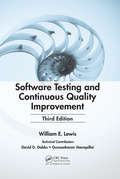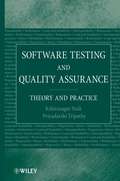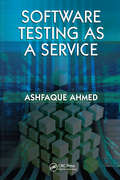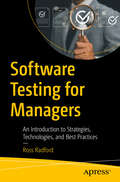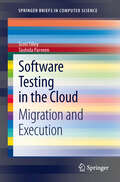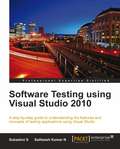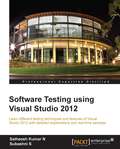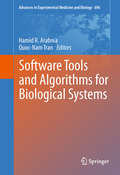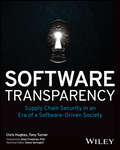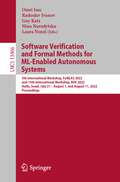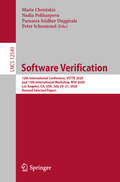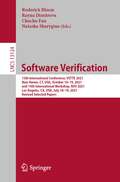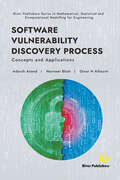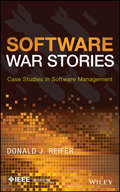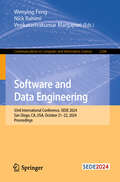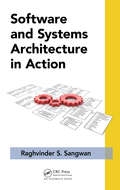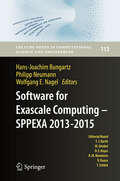- Table View
- List View
Software Testing and Continuous Quality Improvement
by William E. LewisIt is often assumed that software testing is based on clearly defined requirements and software development standards. However, testing is typically performed against changing, and sometimes inaccurate, requirements. The third edition of a bestseller, Software Testing and Continuous Quality Improvement, Third Edition provides a continuous quality framework for the software testing process within traditionally structured and unstructured environments. This framework aids in creating meaningful test cases for systems with evolving requirements. This completely revised reference provides a comprehensive look at software testing as part of the project management process, emphasizing testing and quality goals early on in development. Building on the success of previous editions, the text explains testing in a Service Orientated Architecture (SOA) environment, the building blocks of a Testing Center of Excellence (COE), and how to test in an agile development. Fully updated, the sections on test effort estimation provide greater emphasis on testing metrics. The book also examines all aspects of functional testing and looks at the relation between changing business strategies and changes to applications in development. Includes New Chapters on Process, Application, and Organizational Metrics All IT organizations face software testing issues, but most are unprepared to manage them. Software Testing and Continuous Quality Improvement, Third Edition is enhanced with an up-to-date listing of free software tools and a question-and-answer checklist for choosing the best tools for your organization. It equips you with everything you need to effectively address testing issues in the most beneficial way for your business.
Software Testing and Quality Assurance
by Kshirasagar Naik Priyadarshi TripathyA superior primer on software testing and quality assurance, from integration to execution and automation This important new work fills the pressing need for a user-friendly text that aims to provide software engineers, software quality professionals, software developers, and students with the fundamental developments in testing theory and common testing practices. Software Testing and Quality Assurance: Theory and Practice equips readers with a solid understanding of: Practices that support the production of quality software Software testing techniques Life-cycle models for requirements, defects, test cases, and test results Process models for units, integration, system, and acceptance testing How to build test teams, including recruiting and retaining test engineers Quality Models, Capability Maturity Model, Testing Maturity Model, and Test Process Improvement Model Expertly balancing theory with practice, and complemented with an abundance of pedagogical tools, including test questions, examples, teaching suggestions, and chapter summaries, this book is a valuable, self-contained tool for professionals and an ideal introductory text for courses in software testing, quality assurance, and software engineering.
Software Testing as a Service
by Ashfaque AhmedIn today's unforgiving business environment where customers demand zero defect software at lower costs-it is testing that provides the opportunity for software companies to separate themselves from the competition. Software Testing as a Service explains, in simple language, how to use software testing to improve productivity, reduce time to market, and reduce costly errors. It explains how the normal functions of manufacturing can be applied to commoditize the software testing service to achieve consistent quality across all software projects. This up-to-date reference reviews different software testing tools, techniques, and practices and provides succinct guidance on how to estimate costs, allocate resources, and make competitive bids. Replete with examples and case histories, this resource illustrates how proper planning can lead to the creation of software that's head and shoulders above the competition.
Software Testing for Managers: An Introduction to Strategies, Technologies, and Best Practices
by Ross RadfordSoftware leaders, directors, and managers of all types need to know about software testing. It can be a tough climb up the mountain of technical jargon. Engineers seem to be speaking a language all their own sometimes. Most books on testing are deep in the weeds with technical terms and techniques that simply aren’t applicable even to technical managers. This book provides a high-level perspective on broad topics in a friendly, easy-to-absorb style. Get started and up to speed quickly with immediately useful, actionable guidance. Guidance on team structure, best practices and even common pitfalls will save you time and money, while automation and code reuse will provide exponential value.There’s a gap of knowledge between engineers and their managers; they are almost speaking different languages and the jargon can be confusing. There’s a lot to know about the world of testing. Test from the Top delivers quick, concise guidance to bridge the gap! It offers clear, actionable steps and is a must have for busy leaders who need quick answers.What You Will Learn:How and where to integrate testing in the software development lifecycleTesting terminology and concepts from a management perspectiveCommon pitfalls of testing, how to avoid wasted timeHow to hire test-aware teamsThe value in reusing test code for more generalized automationWho This Book is for:Software managers, Lead Software Engineers, Tech Directors, CTOs, Project Managers, software leaders of all kinds. These leaders understand the value of testing, but have not yet built out extensive automation or team structure. Either new to testing concepts or modernizing systems or looking to improve software quality. Assumed to have a working knowledge of the Software Development Lifecycle and basic project management (no specific methodology required).
Software Testing in the Cloud: Migration and Execution
by Tauhida Parveen Scott TilleyFor a large, complex system, the amount of test cases in a regression test suite can range from a few hundred to several thousands, which can take hours or even days to execute. Regression testing also requires considerable resources that are often not readily available. This precludes their use in an interactive setting, further contributing to an inefficient testing process. Cloud computing offers the use of virtualized hardware, effectively unlimited storage, and software services that can help reduce the execution time of large test suites in a cost-effective manner. The research presented by Tilley and Parveen leverages the resources provided by cloud computing infrastructure to facilitate the concurrent execution of test cases. They introduce a decision framework called SMART-T to support migration of software testing to the cloud, a distributed environment called HadoopUnit for the concurrent execution of test cases in the cloud, and a series of case studies illustrating the use of the framework and the environment. Experimental results indicate a significant reduction in test execution time is possible when compared with a typical sequential environment. Software testing in the cloud is a subject of high interest for advanced practitioners and academic researchers alike. For advanced practitioners, the issue of cloud computing and its impact on the field of software testing is becoming increasingly relevant. For academic researchers, this is a subject that is replete with interesting challenges; there are so many open problems that graduate students will be busy for years to come. To further disseminate results in this field, the authors created a community of interest called "Software Testing in the Cloud" (www.STITC.org), and they encourage all readers to get involved in this exciting new area.
Software Testing using Visual Studio 2010
by N. Satheesh Kumar S. SubashniThis book starts with basic understanding of different types of tests. It then goes about explaining several examples with a step-by-step approach to master concepts and the features needed to help the reader understand testing clearly.If you are a developer, a software tester, or an architect who wishes to master the amazing range of features offered by the Visual Studio 2010 for testing your software applications before going live - then this book is for you. This book assumes that you have a basic knowledge of testing software applications and have good work experience of using Visual Studio IDE.
Software Testing using Visual Studio 2012
by Subashni S Satheesh Kumar NWe will be setting up a sample test scenario, then we'll walk through the features available to deploy tests.This book is for developers and testers who want to get to grips with Visual Studio 2012 and Test Manager for all testing activities and managing tests and results in Team Foundation Server. It requires a minimal understanding of testing practices and the software development life cycle; also, some coding skills would help in customizing and updating the code generated from the web UI testing.
Software Testing with Generative AI
by Mark WinteringhamSpeed up your testing and deliver exceptional product quality with the power of AI tools.The more you test, the more you learn about your software. Software Testing with Generative AI shows you how you can expand, automate, and enhance your testing with Large Language Model (LLM)-based AI. Your team will soon be delivering higher quality tests, all in less time. In Software Testing with Generative AI you&’ll learn how to: • Spot opportunities to improve test quality with AI • Construct test automation with the support of AI tools • Formulate new ideas during exploratory testing using AI tools • Use AI tools to aid the design process of new features • Improve the testability of a context with the help of AI tools • Maximize your output with prompt engineering • Create custom LLMs for your business&’s specific needs Software Testing with Generative AI is full of hype-free advice for supporting your software testing with AI. In it, you&’ll find strategies from bestselling author Mark Winteringham to generate synthetic testing data, implement automation, and even augment and improve your test design with AI. Foreword by Nicola Martin. About the technology There&’s a simple rule in software testing: the more you test, the more you learn. And as any testing pro will tell you, good testing takes time. By integrating large language models (LLMs) and generative AI into your process, you can dramatically automate and enhance testing, improve quality and coverage, and deliver more meaningful results. About the book Software Testing with Generative AI shows you how AI can elevate every aspect of testing—automation, test data management, test scripting, exploratory testing, and more! Learn how to use AI coding tools like Copilot to guide test-driven development, get relevant feedback about your applications from ChatGPT, and use the OpenAI API to integrate AI into your data generation. You&’ll soon have higher-quality testing that takes up less of your time. What's inside • Improve test quality and coverage • AI-powered test automation • Build agents that act as testing assistants About the reader For developers, testers, and quality engineers. About the author Mark Winteringham is an experienced software tester who teaches many aspects of software testing. He is the author of Testing Web APIs. The technical editor on this book was Robert Walsh. Table of Contents Part 1 1 Enhancing testing with large language models 2 Large language models and prompt engineering 3 Artificial intelligence, automation, and testing Part 2 4 AI-assisted testing for developers 5 Test planning with AI support 6 Rapid data creation using AI 7 Accelerating and improving UI automation using AI 8 Assisting exploratory testing with artificial intelligence 9 AI agents as testing assistants Part 3 10 Introducing customized LLMs 11 Contextualizing prompts with retrieval-augmented generation 12 Fine-tuning LLMs with business domain knowledge Appendix A Setting up and using ChatGPT Appendix B Setting up and using GitHub Copilot Appendix C Exploratory testing notes
Software Testing with Visual Studio Team System 2008
by Satheesh N. Kumar Subashni SAn example testing scenario is set up, and used as reference for exploring the testing features available in Visual Studio Team System 2008. This is a concise practical guide that will help you learn testing your software applications using Visual Studio Team System 2008 quickly, with lot of examples and clear explanations. It is packed with screenshots to aid your understanding of the process. This book is for Microsoft developers working with Visual Studio 2008 who need to create a structured testing environment for their applications. No prior knowledge of testing is expected. The reader will need to be familiar with the standard Visual Studio 2008 environment, but anyone who has entered and compiled code in this environment before will easily follow what goes on.
Software Testing: A Craftsman’s Approach, Fifth Edition
by Paul C. Jorgensen Byron DeVriesThis updated and reorganized Fifth edition of Software Testing: A Craftsman's Approach applies the strong mathematics content of previous editions to a coherent treatment of software testing. Responding to instructor and student survey input of previous editions, the authors have streamlined chapters and examples. The Fifth Edition: Has a new chapter on feature interaction testing that explores the feature interaction problem and explains how to reduce tests Uses Java instead of pseudo-code for all examples including structured and object-oriented ones Presents model-based development and provides an explanation of how to conduct testing within model-based development environments Explains testing in waterfall, iterative, and agile software development projects Explores test-driven development, reexamines all-pairs testing, and explains the four contexts of software testing Thoroughly revised and updated, Software Testing: A Craftsman’s Approach, Fifth Edition is sure to become a standard reference for those who need to stay up to date with evolving technologies in software testing. Carrying on the tradition of previous editions, it is a valuable reference for software testers, developers, and engineers.
Software Testing: A Craftsman’s Approach, Fourth Edition
by Paul C. JorgensenThis updated and reorganized fourth edition of Software Testing: A Craftsman's Approach applies the strong mathematics content of previous editions to a coherent treatment of Model-Based Testing for both code-based (structural) and specification-based (functional) testing. These techniques are extended from the usual unit testing discussions to full coverage of less understood levels integration and system testing. The Fourth Edition: Emphasizes technical inspections and is supplemented by an appendix with a full package of documents required for a sample Use Case technical inspection Introduces an innovative approach that merges the Event-Driven Petri Nets from the earlier editions with the "Swim Lane" concept from the Unified Modeling Language (UML) that permits model-based testing for four levels of interaction among constituents in a System of Systems Introduces model-based development and provides an explanation of how to conduct testing within model-based development environments Presents a new section on methods for testing software in an Agile programming environment Explores test-driven development, reexamines all-pairs testing, and explains the four contexts of software testing Thoroughly revised and updated, Software Testing: A Craftsman’s Approach, Fourth Edition is sure to become a standard reference for those who need to stay up to date with evolving technologies in software testing. Carrying on the tradition of previous editions, it will continue to serve as a valuable reference for software testers, developers, and engineers.
Software Tools and Algorithms for Biological Systems
by Hamid R. Arabnia Quoc-Nam Tran"Software Tools and Algorithms for Biological Systems" is composed of a collection of papers received in response to an announcement that was widely distributed to academicians and practitioners in the broad area of computational biology and software tools. Also, selected authors of accepted papers of BIOCOMP'09 proceedings (International Conference on Bioinformatics and Computational Biology: July 13-16, 2009; Las Vegas, Nevada, USA) were invited to submit the extended versions of their papers for evaluation.
Software Transparency: Supply Chain Security in an Era of a Software-Driven Society
by Chris Hughes Tony TurnerDiscover the new cybersecurity landscape of the interconnected software supply chain In Software Transparency: Supply Chain Security in an Era of a Software-Driven Society, a team of veteran information security professionals delivers an expert treatment of software supply chain security. In the book, you’ll explore real-world examples and guidance on how to defend your own organization against internal and external attacks. It includes coverage of topics including the history of the software transparency movement, software bills of materials, and high assurance attestations. The authors examine the background of attack vectors that are becoming increasingly vulnerable, like mobile and social networks, retail and banking systems, and infrastructure and defense systems. You’ll also discover: Use cases and practical guidance for both software consumers and suppliers Discussions of firmware and embedded software, as well as cloud and connected APIs Strategies for understanding federal and defense software supply chain initiatives related to securityAn essential resource for cybersecurity and application security professionals, Software Transparency will also be of extraordinary benefit to industrial control system, cloud, and mobile security professionals.
Software Verification and Analysis
by William Stanley Janusz LaskiThis book addresses the most important techniques in improving the correctness of software, including correctness by construction (top-down refinement), program proving, static analysis and dynamic, execution-based analysis (testing and debugging). Three major software verification techniques are discussed: Semantic program synthesis and analysis, static program analysis and dynamic program analysis. The correctness by construction paradigm is illustrated using the VDM-SL and the corresponding CSK Toolbox. The discussion involves the synthesis of direct and/or indirect specification, interpreting the latter and carrying out high-level testing of the specification. Problems are included in the text and one or more difficult exercises appear at the end of each chapter. Also, where appropriate, STAD's handling of the concepts is illustrated. Written for advanced students and professionals wishing to explore more than one technique, this comprehensive text will be invaluable with its unique integrated approach.
Software Verification and Formal Methods for ML-Enabled Autonomous Systems: 5th International Workshop, FoMLAS 2022, and 15th International Workshop, NSV 2022, Haifa, Israel, July 31 - August 1, and August 11, 2022, Proceedings (Lecture Notes in Computer Science #13466)
by Omri Isac Radoslav Ivanov Guy Katz Nina Narodytska Laura NenziThis book constitutes the refereed proceedings of the 5th International Workshop on Software Verification and Formal Methods for ML-Enables Autonomous Systems, FoMLAS 2022, and the 15th International Workshop on Numerical Software Verification, NSV 2022, which took place in Haifa, Israel, in July/August 2022. The volume contains 8 full papers from the FoMLAS 2022 workshop and 3 full papers from the NSV 2022 workshop. The FoMLAS workshop is dedicated to the development of novel formal methods techniques to discussing on how formal methods can be used to increase predictability, explainability, and accountability of ML-enabled autonomous systems. NSV 2022 is focusing on the challenges of the verification of cyber-physical systems with machine learning components.
Software Verification: 12th International Conference, VSTTE 2020, and 13th International Workshop, NSV 2020, Los Angeles, CA, USA, July 20–21, 2020, Revised Selected Papers (Lecture Notes in Computer Science #12549)
by Nadia Polikarpova Maria Christakis Parasara Sridhar Duggirala Peter SchrammelThis book constitutes the refereed proceedings of the 12th International Conference on Verified Software, VSTTE 2020, and the 13th International Workshop on Numerical Software Verification, NSV 2020, held in Los Angeles, CA, USA, in July 2020. Due to COVID-19 pandemic the conference was held virtually. The 13 papers presented in this volume were carefully reviewed and selected from 21 submissions. The papers describe large-scale verification efforts that involve collaboration, theory unification, tool integration, and formalized domain knowledge as well as novel experiments and case studies evaluating verification techniques and technologies. The conference was co-located with the 32nd International Conference on Computer-Aided Verification (CAV 2020).
Software Verification: 13th International Conference, VSTTE 2021, New Haven, CT, USA, October 18–19, 2021, and 14th International Workshop, NSV 2021, Los Angeles, CA, USA, July 18–19, 2021, Revised Selected Papers (Lecture Notes in Computer Science #13124)
by Natasha Sharygina Roderick Bloem Rayna Dimitrova Chuchu FanThis book constitutes the refereed proceedings of the 13th International Conference on Verified Software, VSTTE 2021, and the 14th International Workshop on Numerical Software Verification, NSV 2021, held online, in July/ October 2021. Due to COVID-19 pandemic the conference was held virtually.There were 10 papers presented in this volume were carefully reviewed and selected from 20 submissions. The papers focuses on challenges of the verification of cyber-physical systems with machine learning components and making large-scale verified software a practical reality and much more.
Software Vulnerability Discovery Process: Concepts and Applications (River Publishers Series in Mathematical and Engineering Sciences)
by Adarsh Anand Navneet Bhatt Omar H AlhazmiThis book is an overview of basics and other related fundamentals pertaining to software vulnerability discovery as a process. This collaboration of academia and industry disseminates various practical mathematical modeling-based tools and analytics used for vulnerability discovery.A big challenge for software developers is producing and maintaining high quality offerings. Recent developments in both academia and industry have seen the devotion of many researchers to the security aspect of software systems. There are various instances where a security breech or more precisely a software vulnerability has led to the colossal loss of resources and, at times, human lives as well. The emergence of this naïve concept from the field of complex systems provides many new opportunities for the software security fraternity and has also raised many new exciting challenges. And so, of late, many practitioners have contributed to this domain.Software Vulnerability Discovery Process: Concepts and Applications is not only for academicians, but also for those who need to understand nature of the vulnerabilities, like a vendor, a client in the domain of complex systems, and for understanding the patch management workflow. Along with these, anyone solving problems within the related application domains will benefit from this compilation.
Software War Stories: Case Studies in Software Management
by Donald J. ReiferA comprehensive, practical book on software management that dispels real-world issues through relevant case studies Software managers inevitably will meet obstacles while trying to deliver quality products and provide value to customers, often with tight time restrictions. The result: Software War Stories. This book provides readers with practical advice on how to handle the many issues that can arise as a software project unfolds. It utilizes case studies that focus on what can be done to establish and meet reasonable expectations as they occur in government, industrial, and academic settings. The book also offers important discussions on both traditional and agile methods as well as lean development concepts. Software War Stories: Covers the basics of management as applied to situations ranging from agile projects to large IT projects with infrastructure problems Includes coverage of topics ranging from planning, estimating, and organizing to risk and opportunity management Uses twelve case studies to communicate lessons learned by the author in practice Offers end-of-chapter exercises, sample solutions, and a blog for providing updates and answers to readers' questions Software War Stories: Case Studies in Software Management mentors practitioners, software engineers, students and more, providing relevant situational examples encountered when managing software projects and organizations.
Software als Medizinprodukt: Entwicklung und Zulassung von Software in der Medizintechnik
by Mark Hastenteufel Sina RenaudLernen Sie mit diesem Buch, wie Sie Software erfolgreich als Medizinprodukt entwickeln und zulassenDie zunehmende Digitalisierung bringt enorme Fortschritte in der Medizin. Softwarelösungen sind längst ein integraler Bestandteil moderner Medizintechnik. Gleichzeitig verschärft sich die Gesetzgebung für die Entwicklung medizinischer Software zunehmend. Viele Software-Hersteller stehen deshalb vor der Herausforderung, die schnellen Entwicklungen mit der langsameren Bürokratie rund um Gesetzesänderungen in Einklang zu bringen. Dieses Buch zeigt Ihnen alles, was Sie über die Entwicklung von Software als Medizinprodukt wissen müssen. Die Autoren erläutern die wichtigen Aspekte entlang des Software-Lebenszyklus und helfen Medizintechnikern bei der Formulierung von Softwareanforderungen für Medizinprodukte. Auch die oft Hardware-lastig formulierten Medizintechnik-Normen erklären die Autoren auf leicht verständliche Weise. Das Buch schlägt eine Brücke zwischen Medizintechnik und IT-Industrie. Neben europäischen Regularien berücksichtigen Mark Hastenteufel und Sina Renaud auch internationale Aspekte. Einblicke in die Branche und Praxis Die Autoren geben Ihnen in diesem Buch zunächst einen kurzen Überblick über die wirtschaftliche Bedeutung von Software als Medizinprodukt. Sie klären, warum Medizintechnik ein bedeutender Wirtschaftsfaktor ist und zeigen, was die Branche besonders macht. Anschließend setzen sie sich mit diesen Kernthemen auseinander:· Die Grundlage: Medical Device Regulation (MDR)· Die Umsetzung: Normen, Spezifikationen und Guidelines· Grundlagen des Software Engineerings· Software als Medizinprodukt· Zulassungen in den USA· Ausblick auf weltweite Zulassungen Damit hilft dieses Buch Medizintechnikern, ihr Wissen über die Digitalisierung auszubauen. Software-Entwicklern erleichtert es den Weg in die Medizintechnik. Eine Empfehlung, wenn Sie mit den Grundlagen vertraut sind Leser sollten für das Buch „Software als Medizinprodukt“ bereits ein gewisses Grundverständnis im Bereich IT und Softwareentwicklung mitbringen, besonders in Hinblick auf Programmierung und Modellierung. Daher ist dieses Werk auf folgende Zielgruppen ausgerichtet:a) Dozierende und Studierende der Fachgebiete Software-Engineering, Medizininformatik und -technikb) Praktiker wie Softwareentwickler, -Projektleiter oder Qualitätsmanager bei Medizintechnikherstellern
Software and Data Engineering: 33rd International Conference, SEDE 2024, San Diego, CA, USA, October 21-22, 2024, Proceedings (Communications in Computer and Information Science #2244)
by Wenying Feng Nick Rahimi Venkatasivakumar MargapuriThis book constitutes the proceedings of the 33rd International Conference on Software and Data Engineering, SEDE 2024, held in San Diego, California, USA, during October 21-22, 2024. The 14 full papers presented in these proceedings were carefully reviewed and selected from 25 submissions. These papers focus on a wide range of topics within Software and Data engineering and have been categorized into the following topical sections: Software Engineering and Data Science & Artificial Intelligence.
Software and Data Engineering: 34th International Conference, SEDE 2025, New Orleans, LA, USA, October 20-21, 2025, Proceedings (Communications in Computer and Information Science #2720)
by Nick Rahimi Venkat Margapuri Noor Amiri GolilarzThis book constitutes the proceedings of the 34th International Conference on Software and Data Engineering, SEDE 2025, held in New Orleans, LA, USA, during October 20–21, 2025. The 26 full papers presented in these proceedings were carefully reviewed and selected from 42 submissions. These papers focus on a wide range of topics within Software and Data Engineering and are categorized into the following topical sections: Software Engineering and Data Science & Artificial Intelligence.
Software and Systems Architecture in Action (Applied Software Engineering Ser.)
by Raghvinder S. SangwanModern-day projects require software and systems engineers to work together in realizing architectures of large and complex software-intensive systems. To date, the two have used their own tools and methods to deal with similar issues when it comes to the requirements, design, testing, maintenance, and evolution of these architectures.Software and
Software and Systems Traceability
by Orlena Gotel Jane Huang Andrea ZismanSoftware and Systems Traceability provides a comprehensive description of the practices and theories of software traceability across all phases of the software development lifecycle. The term software traceability is derived from the concept of requirements traceability. Requirements traceability is the ability to track a requirement all the way from its origins to the downstream work products that implement that requirement in a software system. Software traceability is defined as the ability to relate the various types of software artefacts created during the development of software systems. Traceability relations can improve the quality of a product being developed, and reduce the time and cost of development. More specifically, traceability relations can support evolution of software systems, reuse of parts of a system by comparing components of new and existing systems, validation that a system meets its requirements, understanding of the rationale for certain design and implementation decisions, and analysis of the implications of changes in the system.
Software for Exascale Computing - SPPEXA 2013-2015
by Hans-Joachim Bungartz Wolfgang E. Nagel Philipp NeumannThe research and its outcomes presented in this collection focus on various aspects of high-performance computing (HPC) software and its development which is confronted with various challenges as today's supercomputer technology heads towards exascale computing. The individual chapters address one or more of the research directions (1) computational algorithms, (2) system software, (3) application software, (4) data management and exploration, (5) programming, and (6) software tools. The collection thereby highlights pioneering research findings as well as innovative concepts in exascale software development that have been conducted under the umbrella of the priority programme "Software for Exascale Computing" (SPPEXA) of the German Research Foundation (DFG) and that have been presented at the SPPEXA Symposium, Jan 25-27 2016, in Munich. The book has an interdisciplinary appeal: scholars from computational sub-fields in computer science, mathematics, physics, or engineering will find it of particular interest.
